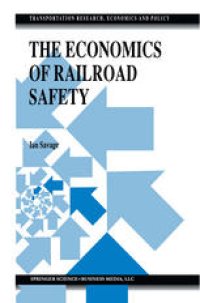
Ebook: The Economics of Railroad Safety
Author: Ian Savage (auth.)
- Tags: Regional/Spatial Science, Industrial Organization, Law and Economics, Economic Policy
- Series: Transportation Research Economics and Policy
- Year: 1998
- Publisher: Springer US
- Edition: 1
- Language: English
- pdf
The American public has a fascination with railroad wrecks that goes back a long way. One hundred years ago, staged railroad accidents were popular events. At the Iowa State fair in 1896, 89,000 people paid $20 each, at current prices, to see two trains, throttles wide open, collide with each other. "Head-on Joe" Connolly made a business out of "cornfield meets" holding seventy-three events in thirty-six years. Picture books of train wrecks do good business presumably because a train wreck can guarantee a spectacular destruction of property without the messy loss of life associated with aircraft accidents. A "train wreck" has also entered the popular vocabulary in a most unusual way. When political manoeuvering leads to failure to pass the federal budget, and a shutdown is likely of government services, this is widely called a "train wreck. " In business and team sports, bumbling and lack of coordination leading to a spectacular and public failure to perform is also called "causing a train wreck. " A person or organization who is disorganized may be labelled a "train wreck. " It is therefore not surprising that the public perception of the safety of railroads centers on images of twisted metal and burning tank cars, and a general feeling that these events occur quite often. After a series of railroad accidents, such as occurred in the winter of 1996 or the summer of 1997, there are inevitable calls that government "should do something.
The Economics of Railroad Safety stems from the traditions of industrial organization and law and economics. The objective of the book is to examine the exact nature of the `safety problem': how much safety should be provided; what might hinder obtaining such a level of provision; and what we can do about it. Discussion of safety is often infused with emotion. By contrast, the author uses a logical approach to laying out the economics of safety, allowing the informed reader to understand exactly what constitute the main issues. Therefore, while the book deals specifically with freight railroads, the theory is applicable to all forms of transportation.
The Economics of Railroad Safety is divided into three main sections. The first section puts the railroad safety issue into context. The second section provides a consideration on the economics of safety. The objectives of the third section are to discuss why the market may not produce the socially-optimal level of safety, and to present the range of policy responses that might be deployed to deal with any market failures. The book concludes with a summary of the public policy recommendations on grade crossing, trespassers, industrial injuries, and operational safety.